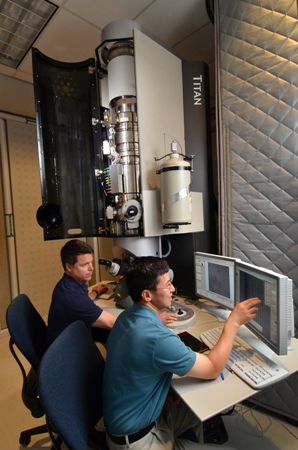According to materials scientists, Paul Kotula and Ping Lu, Sandia’s new aberration-corrected scanning transmission electron microscope (AC-STEM) is 50-100 folds better in terms of resolution and time taken for sample analysis when compared to the lab’s older analytical microscopes.
 Principal investigators Paul Kotula, left, and Ping Lu of Sandia National Laboratories show off the Labs’ new aberration-corrected scanning transmission microscope, which has a unique combination of X-ray detectors and very high resolution and is capable of doing analyses in far less time than its predecessor. (Photo by Randy Montoya)
Principal investigators Paul Kotula, left, and Ping Lu of Sandia National Laboratories show off the Labs’ new aberration-corrected scanning transmission microscope, which has a unique combination of X-ray detectors and very high resolution and is capable of doing analyses in far less time than its predecessor. (Photo by Randy Montoya)
The $3.2 million FEI Titan G2 8200 provides accelerated electron beams at voltages between 80 and 200 kV, thus enabling scientists to perform nanoscale analysis of structural properties. According to Kotula, the microscope with ultra-high resolution and X-ray detectors took seven minutes for an analysis when compared to a two-hour period for the same analysis on the older tool.
Due to its high sensitivity, the AC-STEM is operated remotely from a basement lab nearby the environment-controlled room that accommodates it. The instrument can be operated from 1,000 miles away. Lu informed that the instrument uses a novel in-lens design wherein four X-ray detectors encircle a sample positioned in the center, thus providing increased collection efficiency.
Kotula stated that computational components and extra lenses in the AC-STEM eliminate limitations caused by lens aberrations. The instrument’s aberration-correction technology enables it to focus the electrons towards a fine point on a sample. Scanning of sample at very high magnification as well as a small probe are essential for atomic resolution.
The AC-STEM beam’s intensity can be controlled efficiently thanks to its numerous adjustable parameters, said Kotula. The instrument is capable of studying materials in the micron realm. The room where the instrument is placed must maintain stability in electromagnetic fields, temperature, acoustics, and vibration. The walls of the room are lined with acoustic chilled water panels.
Manager Jim Aubert stated that this novel transmission electron microscope is an advanced instrument capable of analyzing all kinds of bulk materials such as solid, liquid and gas and performing microstructural characterization such as spectroscopy, diffraction and optics.